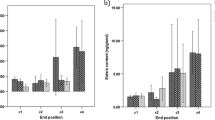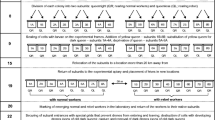Summary:
The requeening process was investigated under emergency conditions in honey bee colonies (Apis mellifera L.). The progression of queen cell construction was closely monitored after removal of the mother queen, and the newly-emerged queens were measured for several physical traits to quantify their reproductive potential (= quality). The results suggest that workers regulate the queen rearing process by differentially constructing cells. Workers built different numbers of queens cells from different ages of brood and non-randomly destroyed over half (53%) of the initiated cells before their emergence. For those queens whose cells were not torn down, the variation in reproductive quality was limited, varying only slightly among age groups for queen size. Several hypotheses are discussed which might explain the adaptive benefit of worker regulation during queen rearing.
Similar content being viewed by others
Author information
Authors and Affiliations
Additional information
Received 21 September 1998; revised 19 January 1999; accepted 9 March 1999.
Rights and permissions
About this article
Cite this article
Hatch, S., Tarpy, D. & Fletcher, D. Worker regulation of emergency queen rearing in honey bee colonies and the resultant variation in queen quality. Insectes soc. 46, 372–377 (1999). https://doi.org/10.1007/s000400050159
Issue Date:
DOI: https://doi.org/10.1007/s000400050159




